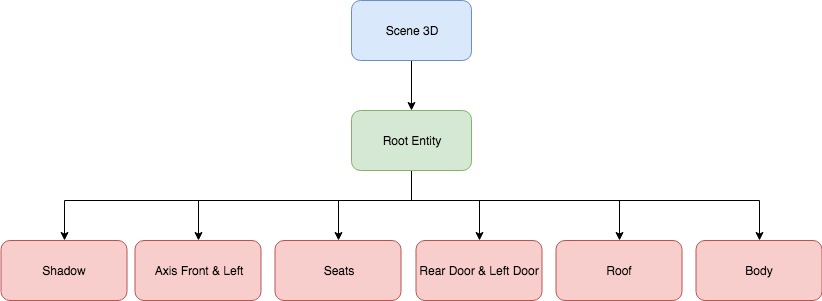Neptune 3 UI - 3D Integration
In Neptune 3, a built-in application called "com.luxoft.vehicle" is included as the vehicle settings application and contains a car 3D scene on top of its content. The 3D scene is renderred by Qt 3D that provides functionality for near-realtime simulation systems with support for 2D and 3D rendering in both Qt C++ and Qt Quick applications.
3D Modeling
A general question about a 3D framework is to provide ways to draw 3D shapes, move them around and move the camera. This is, of course, a sensible baseline, and additional wishes typically include the following:
- Mesh: A mesh is a collection of vertices and edges which are probably triangulated and describes the shape of an object in 3D space
- Material: A material is a set of coefficients that define how the lighting should be applied to the model and interacts with the surface
- Shader: A shader is a programmable shading that is used to do shading, as the production of appropriate levels of color within an image, as well as to produce special effects or do video post-processing
- Texture: Textures are typically used for images to decorate 3D models, but for other purposes it can also be used to store many different kinds of data
- Camera: The first thing to do in the projection of the screen of a scene is to convert 3D coordinates into 2D coordinates. To specify the projection, the points in the 3D scene are used on a virtual screen space. The parameters of a projection will not be entered directly, instead, a virtual camera is configured and placed.
- Animation: Movements of objects are important and can be accomplished by altering the object positions
Qt 3D
The Qt 3D provides some functionalities for modern 3D rendering backed by the performance of OpenGL across the platforms supported by Qt. Qt3D allows developers not only to visualize 3D contents but also to freely customize and control the appearance of each object by using built-in materials or by providing custom GLSL shaders. These controls are also accessible through QML that extends the ability to create a 3D user interface. Integration of 2D and 3D contents is enabled by the Scene3D component through QML. Qt3D is an Entity Component System (ECS), an architectural pattern used mostly in game development.
An application that uses the ECS pattern involves the following:
- Entity: A container for any components that can be added, usually hierarchical. An entity represents an object of components but by itself is devoid of any specific behavior or characteristics. (An entity can also have sub-entities)
- Component: Set of objects through which behaviors and data can be added to an entity

An Entity with a Component attached will tell the system that it needs to be rendered and how to render it. The components of each entity could consist of a material, mesh or transformation. These components should be defined as the components of a particular entity with a given identity of each component. A material component could have a material effect that contains the rendering technique. In addition, within the rendering technique, the shader programs can also be specified. These shader programs can be an external shader files or directly written in QML. The 3D model might has textures, and the connection between the 3D model and the textures can be binded by using the shader and include the material component which has this material effect to the same entity as the mesh component.
3D Integration in Neptune 3 UI
The current structure of the vehicle application:

As shown in the above image, each part of the vehicle has its own entity that contains all the necessary parts, such as Mesh, Transformation and Material. Those entities are tailored to the root entity of the whole Scene 3D.
Neptune 3 UI has an own custom physical based material with Cook Torrance GGX distribution since Qt3D does not provide any for OpenGL ES 2.0. It is required, because it has microfacet theory based lightning, which adds more realistic lightning to the car. A car model can be mostly painted with a single color, so it is easy to integrate lightning calculations. Also most models today are modeled with PBR (Metal Roughness) materials in mind, which makes model import easier.
Animations in vehicle applications are made mostly with matrices transformations. E.g. a door animation is done by: transform door to another origin, rotate it, transform back. So the door will not rotate around its own axis.
© 2018 Pelagicore AG. Documentation contributions included herein are the copyrights of their respective owners. The documentation provided herein is licensed under the terms of the GNU Free Documentation License version 1.3 as published by the Free Software Foundation. Qt and respective logos are trademarks of The Qt Company Ltd. in Finland and/or other countries worldwide. All other trademarks are property of their respective owners.
